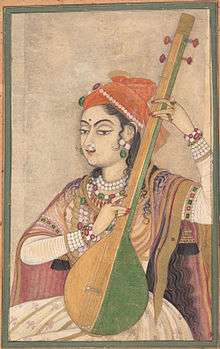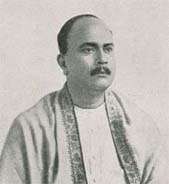Music of West Bengal
The music of West Bengal includes multiple indigenous musical genres such as Baul, Bishnupuri Classical, Kirtan, Shyama Sangeet, Rabindra Sangeet, Nazrul Geeti, Atulprasadi, Dwijendrageeti, Kantageeti, Ganasangeet, Adhunik Gaan, Sumaner gaan, Bengali rock. The city of Darjeeling, which has many Nepali people, is a center for Nepali rock, too.

| Music of India | |
|---|---|
 A Lady Playing the Tanpura, c. 1735 (Rajasthan) | |
| Genres | |
| Traditional
Modern | |
| Media and performance | |
| Music awards | |
| Music festivals | |
| Music media | |
| Nationalistic and patriotic songs | |
| National anthem | Jana Gana Mana |
| Regional music | |
| |
Bishnupur Gharana
The Bishnupur Gharana is the sole Classical (Drupad) gharana of Bengal. It originated in Bishnupur, Bankura by the court musicians of the Malla Kings.[1] Bahadur Khan of Delhi, a descendant of the Tansen, was the father of Bishnupur Gharana. Bahadur Khan was brought to Bishnupur by Malla King Raghunath Singha II.
Baul sangeet
The bauls are a mystic group of singers and musicals, immensely popular in the countryside. They perform using a khamak, ektara and dotara.
Rabindra Sangeet
Rabindra Sangeet (Bengali: রবীন্দ্রসঙ্গীত Robindro shonggit, Bengali pronunciation: [ɾobindɾo ʃoŋɡit]), also known as Tagore Songs, are songs written and composed by Rabindranath Tagore.[2] They have distinctive characteristics in the music of Bengal, popular in India and Bangladesh.[3][4]
Rabindra Sangeet has been an integral part of Bengal culture for over a century.[4][5] Indian social reformer Swami Vivekananda became an admirer of Rabindra Sangeet in his youth. He also composed music in the Rabindra Sangeet style, for example Gaganer Thale in Raga Jaijaivanti.[4]
Tamang Selo
A genre of Nepali Folk song of the Tamang people and popular amongst the Nepali-speaking community in West Bengal, India and around the world. It is accompanied by Tamang instruments, the Madal, Damphu and Tungna, although now-a-days musicians have taken to modern instruments. A Tamang Selo can be catchy and lively or slow and melodious and is usually sung to convey sorrow, love, happiness or day to day incidents and stories of folklore.[6]
Hira Devi Waiba is hailed as the pioneer of Nepali Folk songs and Tamang Selo.[7] Her song 'Chura ta Hoina Astura' (चुरा त होइन अस्तुरा) is said to be the first Tamang Selo ever recorded.[8] She has sung nearly 300 songs through her musical career spanning 40 years. After Waiba's death in 2011, her son Satya Waiba (producer) and Navneet Aditya Waiba (singer) collaborated and re-recorded her most iconic songs and released an album titled Ama Lai Shraddhanjali (आमालाई श्रद्धाञ्जली-Tribute to Mother).[9][10][11]
Shyama Sangeet
Shyama Sangeet (Bengali: শ্যামা সঙ্গীত) is a genre of Bengali devotional songs dedicated to the Hindu goddess Shyama or Kali which is a form of supreme universal mother-goddess Durga or parvati. It is also known as Shaktagiti or Durgastuti.[12]
Shyama Sangeet appeals to the common man because it is a musical representation of the relationship of eternal and sublime love and care between the mother and her child. It is free of the common rituals of worship and also the esoteric practice of the Tantra.
Nazrul Geeti
Nazrul Geeti or Nazrul Sangeet, literally "music of Nazrul," refer to the works of Kazi Nazrul Islam, a Bengali poet and national poet of Bangladesh and active revolutionary during the Indian Independence Movement. Nazrul Sangeet/Geeti incorporate revolutionary notions as well as more spiritual, philosophical and romantic themes.
Dwijendrageeti
Dwijendralal Ray's Dwijendrageeti (the Songs of Dwijendralal), which number over 500, create a separate subgenre of Bengali music. Two of Dwijendralal Ray's most famous compositions are Dhana Dhanya Pushpa Bhara and Banga Amar Janani Amar. Ray is regarded as one of the most important figures in early modern Bengali literature.
Atulprasadi

Atulprasadi (Bengali: অতুলপ্রসাদী) or the Songs of Atulprasad Sen (1871–1934), one of the major lyricist and composers of early-modern period, is also widely popular in Pachimbanga.[13] Atul Prasad is credited with introducing the Thumri style in Bengali music.[13] His songs centred on three broad subjects - patriotism, devotion and love.[13]
Prabhat Samgiita
Prabhát Saḿgiita (Bengali: প্রভাত সঙ্গীত Probhat Shongit, Bengali pronunciation: [pɾɔbhat ʃɔŋɡit] - see spelling variations Prabhat Samgiita#Name and Variants), also known as Songs of a New Dawn and Prabhat Songs, are songs composed by Prabhat Ranjan Sarkar.[14] Sarkar composed a total of 5,018 songs, including the lyrics and the tune, in a period of eight years from 1982 until his death in 1990,[15] making using of eight different languages: Bengali, Hindi, English, Sanskrit, Urdu, Magahi, Maithili and Angika.[16]
Adhunik
Adhunik sangeet literally means "modern songs". In the period just before Indian independence, several new minor musical genres emerged, mainly in the form of playback songs for movies. A miscellaneous category, Adhunik sangeet, was created, since, at that time, this music was "modern".
Jeebonmukhi
There is a new genre in Bengali music called ‘Jibonmukhi Gaan’. Jibonmukhi gaan means ‘songs about life’. Suman Chattapaddhay first started this type of music by writing songs about everyday life and ordinary people although it is widely believed that Dr. Bhupen Hazarika was also a pioneer of this genre. Eventually Nachiketa Chakraborty, Anjan Dutt, Silajit Majumder and many others have followed Suman's footsteps.
Band music and Bengali rock
Mohiner Ghoraguli is widely credited with being the first Bengali Band (in West Bengal) and also India's first. Later, as Western influences became more widespread, the Bengali band became popular with young people during the 1980s and 1990s, both in India and Bangladesh, and has since become entrenched in modern Bengali culture.
Bengali bands use a wide variety of styles such as rock, pop, hard rock, heavy metal, grunge, folk, and fusion. Their music is influenced both by popular American music as well as traditional Bengali folk music such as shyama sangeet and baul.
Like popular music in other countries, Bengali bands are very popular among Bengali young people.
Popular Rock Bands
| Year formed | Band name | Genre | Language |
|---|---|---|---|
| 1975 | Moheener Ghoraguli | Bengali rock | Bengali |
| 1990 | Krosswindz | Bengali rock, fusion | Bengali, English, Hindi |
| 1991 | Chandrabindoo | Bengali rock | Bengali |
| 1992 | Cactus | Bengali rock, hard rock | Bengali |
| 1996 | Hip Pocket | Rock, hard rock | English |
| 1998 | Fossils | Bengali rock, hard rock, metal | Bengali, English, Hindi |
| 1998 | Kalpurush[17] | Bengali Rock, Bengali Pop, Rock, Pop | Bengali, Hindi |
| 1999 | Bhoomi | Bengali rock | Bengali |
| 1999 | Skinny Alley | Rock, alternative rock | English |
| 1999 | Lakkhichhara | Bengali rock | Bengali |
| 2001 | Cassini's Division | Rock, alternative rock | English |
| 2002 | Insomnia | Bengali rock, alternative, nu metal | English, Bengali |
| 2005 | Rikterskale | Bangla Rock | |
| 2005 | Prithibi | Bengali rock | Bengali |
| 2005 | Agnish | Bengali Rock, Hard rock, Rock n Roll | Bengali |
| 2005 | Calcutta Blues | Bengali rock | Bengali |
| 2006 | Destiny[18] | Progressive, neo-classical | |
| 2006 | Pinknoise | Experimental rock, alternative rock | English |
| 2006 | Pseudonym | Alternative rock, hard rock | English |
| 2006 | Kanvas | Alternative rock, Folk rock | Bengali, Hindi |
| 2007 | Five Little Indians | Alternative rock | English |
| 2008 | soul unity of rhythm | Alternative rock | Bengali |
| 2009 | Kendraka | Jazz rock | |
| 2010 | Underground Authority | Alternative rock, rap rock, hard rock | Hindi, English, Bengali |
| 2012 | RobiONobin | Folk rock | |
| 2013 | Lotus Eater | Country, Alternative rock, rap rock soft rock, folk fusion, rock 'n' roll | Hindi, English, Bengali https://web.archive.org/web/20150218104000/http://www.fruithuntt.com/lotus-eater/ |
| 2014 | Cross Chords | Experimental Rock, Progressive Rock, Metal | Bengali, English |
| Parama[17] | |||
| Aurko[17] | |||
| 2015 | the troubadours | Folk, Blues, mainly known for their Protest songs, such as 'Raasta ta howa dorkar' | Bengali, English |
Nepali Rock
Rock at Someplace Else (Kolkata)
Someplace Else is a pub in Kolkata which features daily performances by live bands. Since 1994 it has been promoting different kinds of music, and established artists share the space with aspiring performers. The pub is situated inside the Park Hotel, and regarded as a heritage spot of the city. Famous bands like Skinny Alley, Hip Pocket (a regular band), Lou Majaw, Prestorika, Parikrama, Indian Ocean, Soulmate, Cassini's Division, Underground Authority, The Supersonics and many international musical acts have performed in this pub.[19] International artists like Mumford & Sons, Laura Marling, QED (band), Dub FX and many more have performed in this pub. The pub hosts 3285 hours of live music every year, the most anywhere in India (approximately nine hours of live music daily).
Daily Bands
| Day | Bands |
|---|---|
| Monday | Open Mind (Open Mic Session) and Guest Band |
| Tuesday | Krosswindz |
| Wednesday | Hip Pocket and Pseudonym |
| Thursday | Span |
| Friday | Hip Pocket and Insomnia |
| Saturday | Guest Band and Saturday Night Blues |
| Sunday | Orient Express and Crystal Grass |
Urban Music
Raz Dee, A Canadian Bengali singer started signing RnB music in west Bengal. Now it is getting popular.
See also
- Tamang Selo
- Bengali folk literature
- Culture of Bengal
- Culture of India
- Culture of West Bengal
- Music of Bangladesh
- Music of Bengal
- Music of India
References
- "Culture of Bishnupur". Archived from the original on 5 February 2012. Retrieved 5 December 2011.
- Sigi, Rekha (2006). Gurudev Ravindra Nath Tagore A Biography. Diamond Pocket Books (P) Ltd. p. 90. ISBN 978-81-89182-90-8.CS1 maint: ref=harv (link)
- Tagore, Rabindranath (2007). Boyhood Days. Penguin Books India. p. xii. ISBN 978-0-14-333021-9.CS1 maint: ref=harv (link)
- "Magic of Rabindra Sangeet". Deccan Herald. Archived from the original on 9 July 2013. Retrieved 9 July 2013.
- Dasgupta, Sanjukta; Guha, Chinmoy (2013). Tagore-At Home in the World. SAGE Publications. p. 252. ISBN 978-81-321-1084-2.CS1 maint: ref=harv (link)
- (ACCU), Asia⁄Pacific Cultural Centre for UNESCO. "Asia-Pacific Database on Intangible Cultural Heritage(ICH)". www.accu.or.jp. Retrieved 19 July 2018.
- "The Telegraph - Calcutta (Kolkata) | North Bengal & Sikkim | Hira Devi dies of burn injuries". www.telegraphindia.com. Retrieved 19 July 2018.
- "चुरा त होइन अस्तुरा - पहिलो तामाङ सेलो गीत ? - Tamang Online". Tamang Online. 7 December 2016. Retrieved 19 July 2018.
- "Daughter revives mother's songs". The Telegraph. Retrieved 19 July 2018.
- "Songs of Tribute". The Himalayan Times. 10 January 2017. Retrieved 19 July 2018.
- "छोराछोरीले दिए हीरादेवीलाई श्रद्धाञ्जली" (in Nepali). Retrieved 19 July 2018.
- Sayeed, Khan Md (2012). "Shyamasangit". In Islam, Sirajul; Jamal, Ahmed A. (eds.). Banglapedia: National Encyclopedia of Bangladesh (Second ed.). Asiatic Society of Bangladesh.
- Arnold, Alison (2000). The Garland Encyclopedia of World Music. Taylor & Francis. p. 851. ISBN 0-8240-4946-2.
- Subramanya, Mysore V. (17 March 2008). "DANCE/MUSIC REVIEW - Prabhat Sangeeth". Deccan Herald. Archived from the original on 12 October 2013. Retrieved 1 February 2013.
- "Homage to spiritual guru". Calcutta, India: The Telegraph (Calcutta). 20 September 2004. Retrieved 1 February 2013.
- Sarkar, Subhas (31 December 2010). Prabháta Samgiita: A Literary and Philosophical Appreciation (First ed.). Ananda Marga Publications. ISBN 978-81-7252-260-5. OCLC 704229361.
- "Mirchi Sarod Sandhya comes rocking! - The Times of India". The Times Of India.
- "Kolkata Bangla Band DESTINY - Songs & Interview with Band Members". Washington Bangla Radio. 26 August 2011. Retrieved 27 April 2018.
- "Someplace Else, Kolkata - Rock Bands". Calcutta, India: The Times of India. 25 June 2011.